This stuffed prime rib features an amazing dijon, horseradish, and rosemary crust that changes the game. Of all the prime rib recipes I’ve done for this site, this one seems to be the crowd favorite.
Don’t be intimidated by unrolling this pricey cut of meat. Go slow, take your time and it’s actually really easy.
What’s Better, Bone-in or Boneless?
The bone-in vs. boneless debate with prime rib is more about cooking style than flavor. While bones do add some flavor, it’s pretty localized—just a thin layer of meat near the bone gets the benefit.
What bones really do is help insulate the roast, shielding it from direct heat. This added layer of protection is beneficial, especially if you’re using high heat to sear or finishing the roast on a grill.

That said, boneless prime rib is easier to cut open for stuffed prime rib. It’s also easier to carve and serve, so it’s great if you want convenience.
Bone-in can give you a little more drama for presentation, and some folks love gnawing on those bones later!
No matter which you choose, focus on the quality of the beef. Look for good marbling, as that’s what gives the meat its rich, buttery flavor. And remember, you’re paying by the pound and those bones are heavy.
What Temperature Is Prime Rib Done?
Cooking prime rib on the grill is all about hitting the right internal temperature for the level of doneness you want. Stuffed prime rib is no different.
The trick is not to leave it on the grill until it reaches that temperature, I’ll explain in a minute.
For rare, aim for a rested temperature of 120°F; for medium-rare, go to 130°F; and for medium, you’re looking at 140°F. Prime rib is best at medium-rare to medium because it stays tender and juicy while showcasing its amazing flavor.

Use a reliable meat thermometer to check the internal temperature at the thickest part of the stuffed prime rib, avoiding the bone if it’s bone-in. And here’s the key: the meat will continue to cook as it rests, climbing about 12-15°F.
So, pull the stuffed prime rib off the grill or out of the oven when it’s at least 10°F below your desired serving temperature. Let the meat rest for 25-30 minutes before carving and it will be perfect!
How Many Pounds of Prime Rib Should I Buy?
When planning how much stuffed prime rib to serve, aim for about one pound per person if you’re buying bone-in. The bone adds weight, so this ensures there’s enough meat for everyone.
If you’re going with boneless prime rib, about ¾ pound per person is usually plenty.
If you’re feeding big eaters or want leftovers (because who doesn’t love leftover prime rib?), consider bumping it up to 1½ pounds per person for bone-in or one pound for boneless.
Tap Images Below For Amazing Side Dishes
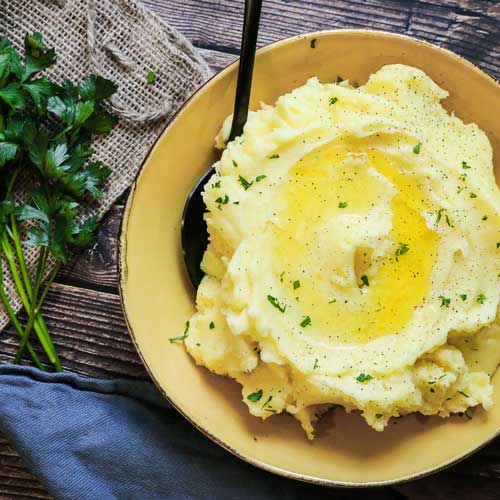
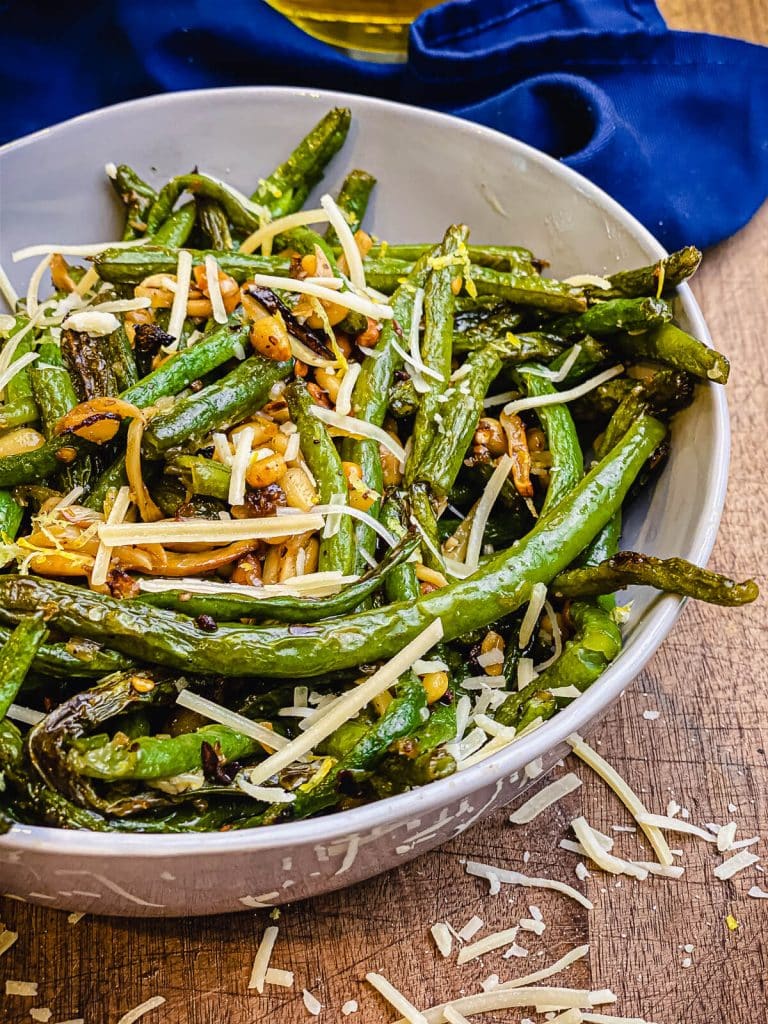


Tips For Making Stuffed Prime Rib
Positioning: Be sure you place your roast as far away from the hot coals as possible, and ensure the cap of the stuffed prime rib is facing away from the heat.
Tempering: Let your stuffed prime rib sit on the counter for at least an hour before putting it on the grill. This will ensure a more even cook.
Resting: Let the meat rest for at least 30 minutes before slicing it.
Stuffing: Allow the sauteed ingredients to cool before adding them to the butter.
Additional Questions Asked About Prime Rib
How long should I cook prime rib per pound? Cooking times vary based on grill / oven temperature and desired doneness. For example, at 225°F, it takes about 35 minutes per pound. However, using a reliable meat thermometer is the best method to determine doneness.
What seasoning or rub should I use for prime rib? Many recipes recommend a simple seasoning of kosher salt and freshly ground black pepper. Some folks also add garlic, herbs like rosemary or thyme, or a mustard crust for added flavor to the perfect prime rib.
Is it necessary to sear prime rib before roasting? Searing can help develop a flavorful crust. Some methods suggest searing before roasting. I recommend starting at a low grill / oven temperature and then searing the stuffed prime rib to finish it.
How long should prime rib rest after cooking? I always let the roast rest for about 20-30 minutes after cooking. This allows the juices to redistribute, resulting in a more juicy roast.
Can I cook prime rib in advance? While it’s best enjoyed fresh, you can cook prime rib in advance. If doing so, slightly undercook it, refrigerate, and then reheat gently to avoid overcooking.
How do I store and reheat leftover prime rib? Store leftovers in an airtight container in the refrigerator for up to 3-4 days. To reheat, wrap slices in foil and warm in a low-temperature oven (around 250°F) until heated through, to maintain tenderness.
How To Make Stuffed Prime Rib
Serves: 4 | Prep Time: 20 Mins | Cook Time: 2.5 hours
Ingredients
1 4 lb boneless prime rib
⅓ cup dijon mustard
¼ cup prepared horseradish, drained
3 tbsp fresh rosemary, minced
2 tbsp Kosher salt, Diamond Crystal
1 tbsp fresh cracked black pepper
Stuffing
1 stick unsalted butter
1 ½ lb fresh spinach, sautéed
8 oz. baby bella mushrooms, finely chopped & lightly sautéed
5 cloves garlic, minced lightly sautéed
1 medium shallot, minced & lightly sautéed
½ tsp red pepper flakes, optional
Step 1: Light grill (or oven) and set up for two zone cooking. Establish temperature at 225°F. While the grill or oven are preheating, add all ingredients for the stuffing into a mixing bowl. Mix well to form a thick butter paste and set aside. Note* Ensure the sauteed items are cool before adding them to the butter. Mix together the mustard and horseradish, and set aside.


Step 2: Using a sharp boning knife, start at the top of the roast and gently feather the blade through the roast to unroll it.




Step 3: Season the inside of the unrolled roast with half of the salt and pepper, or favorite steak seasoning. If you’re using any brand other than Diamond Crystal, reduce the amount of salt by half.
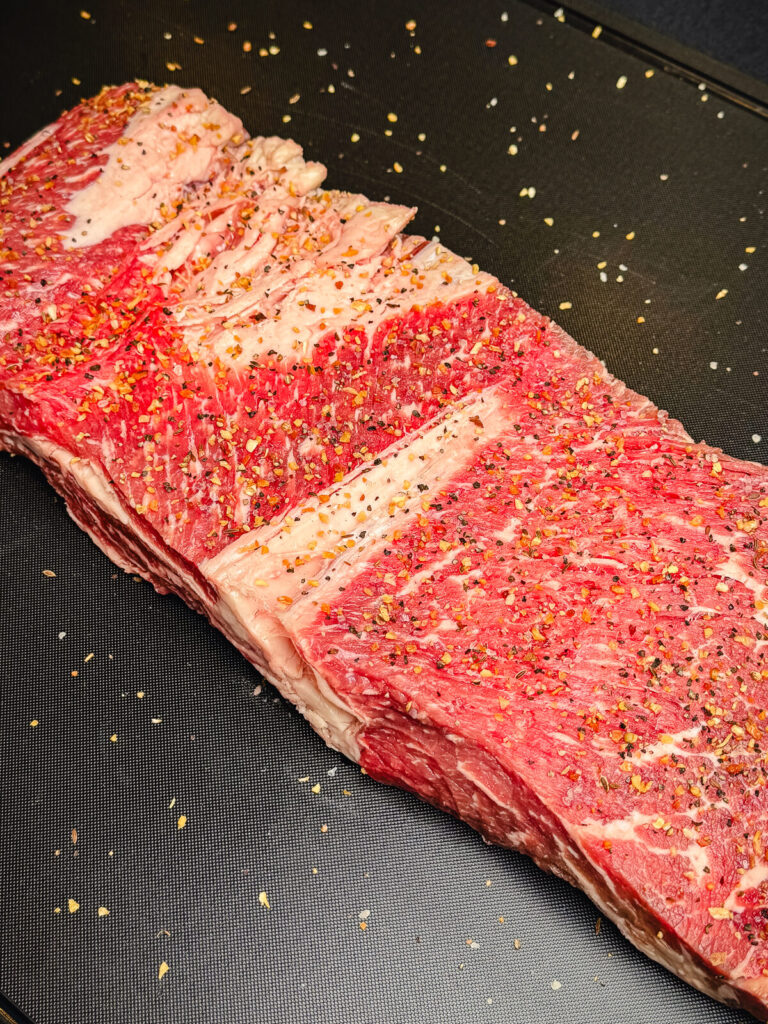
Step 4: Evenly spread the butter mixture onto the unrolled roast.


Step 5: Gently roll the roast back up, being careful not to force the mixture out the sides. Then, tie it with butcher’s twine to hold its shape.

Step 6: Coat with dijon horseradish, season with remaining salt and pepper, and chopped rosemary.


Step 7: Place the roast on the grill over indirect heat, ensuring the cap of the roast is facing away from the heat source. Let the roast cook until it reaches an internal temperature of 100° F.

Step 8: Remove roast from the grill and stoke the coals till the grill reaches 700°F (or as hot as your grill or oven will go). Place the roast back on the grill over indirect heat and allow it to roast till internal temperature reaches 115°F. Remove the roast from the grill and allow it to rest for 30 minutes. Carry-over cooking will bring the roast up to about 130°F.
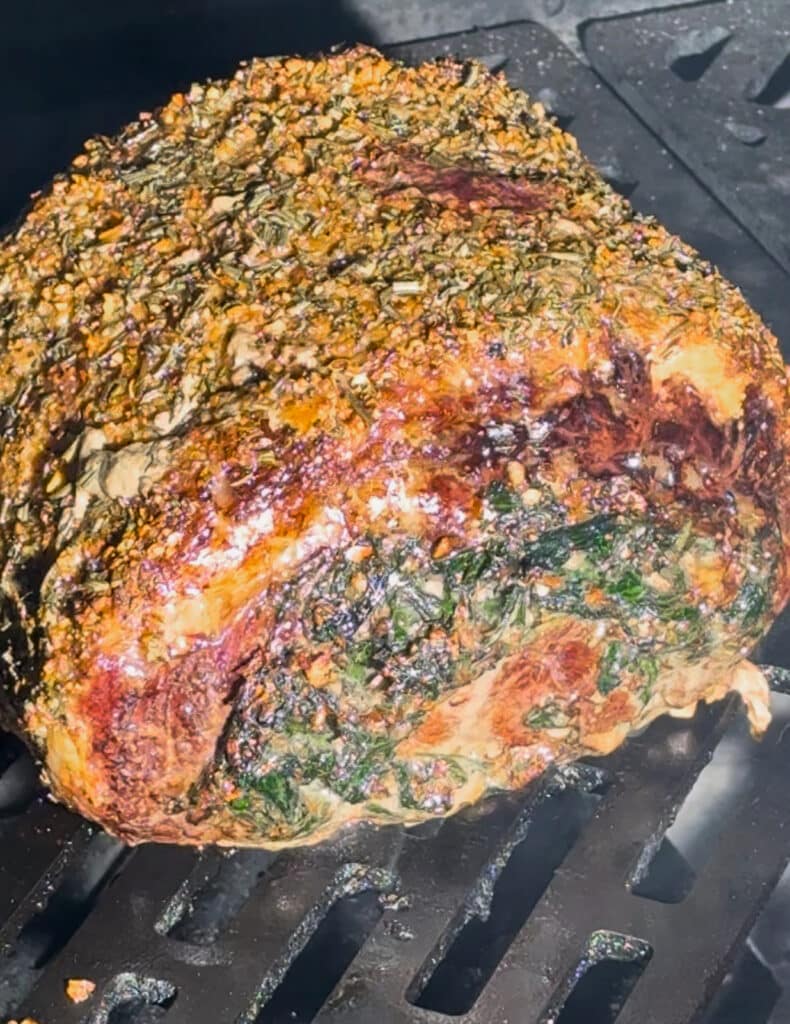
Step 9: Slice the roast and serve with garlic mashed potatoes and horseradish cream sauce.
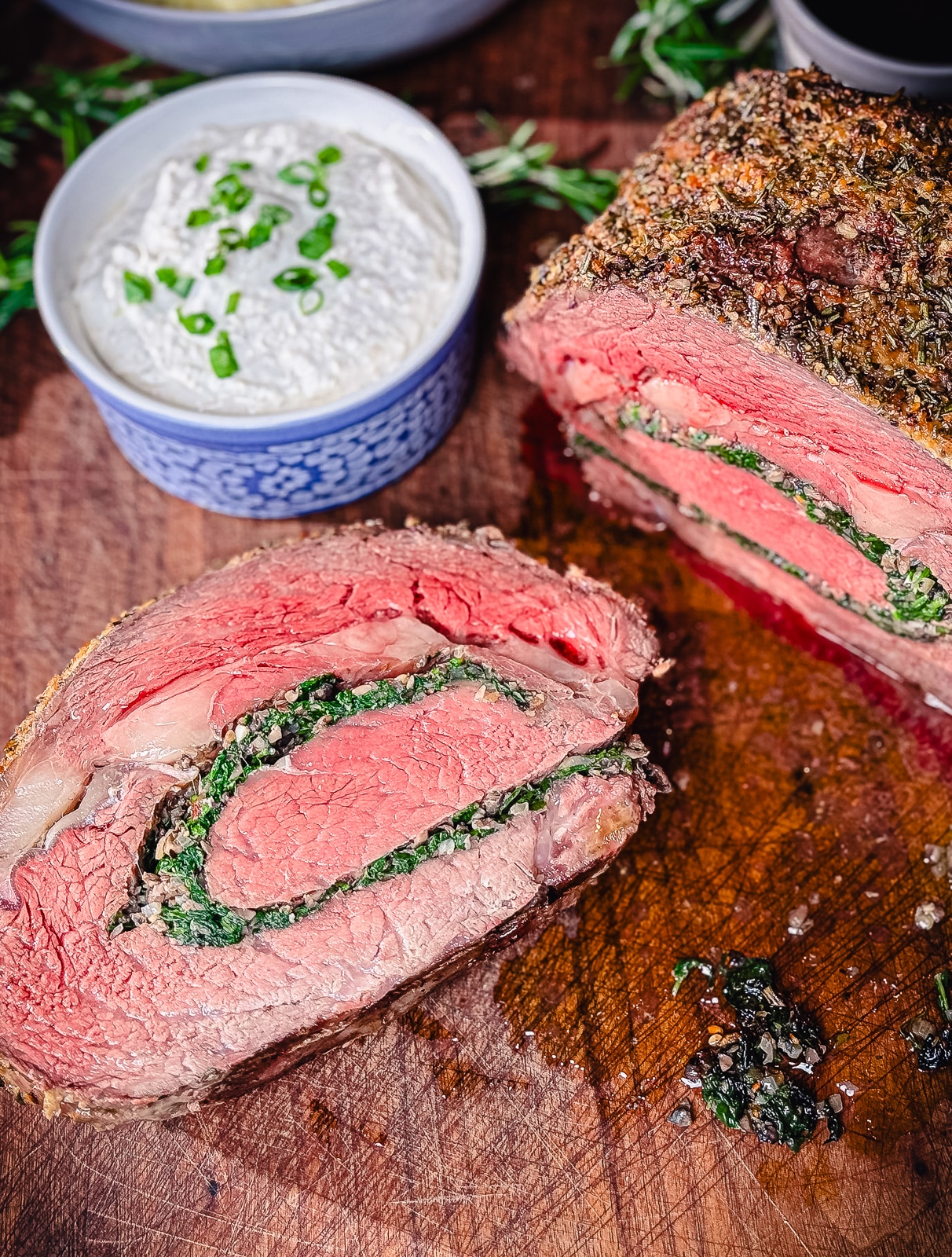
Ingredients
- 1 4 lb boneless prime rib
- ⅓ cup dijon mustard
- ¼ cup prepared horseradish drained
- 3 tbsp fresh rosemary finely chopped
- 2 tbsp kosher salt Diamond Crystal
- 1 tbsp fresh cracked black pepper
Stuffing
- 1 stick unsalted butter
- 1½ lb fresh spinach sautéed
- 8 oz baby bella mushrooms finely chopped & lightly sautéed
- 5 cloves garlic minced
- 1 medium shallot finely chopped & lightly sautéed
- ½ tsp red pepper flakes optional
Instructions
- Light grill (or oven) and set up for two zone cooking. Establish temperature at 225°F. While the grill or oven are preheating, add all ingredients for the stuffing into a mixing bowl. Mix well to form a thick butter paste and set aside. Note* Ensure the sautéed items are cool before adding them to the butter. Combine the mustard and horseradish and set aside.
- Using a sharp boning knife, start at the top of the roast and gently feather the blade through the roast to unroll it.
- Season the inside of the unrolled roast with half of the salt and pepper. If you’re using any brand other than Diamond Crystal, reduce the amount of salt by half.
- Evenly spread the butter mixture onto the unrolled roast.
- Gently roll the roast back up, being careful not to force the mixture out the sides. Then, tie it with butcher’s twine to hold its shape.
- Coat the roast with the dijon horseradish, season with remaining salt and pepper and chopped rosemary.
- Place the roast on the grill over indirect heat, ensuring the cap of the roast is facing away from the heat source. Let the roast cook until it reaches an internal temperature of 100°F.
- Remove roast from the grill and stoke the coals till the grill reaches 700°F (or as hot as your grill or oven will go). Place the roast back on the grill over indirect heat and allow it to roast till internal temperature reaches 115°F. Remove the roast from the grill and allow it to rest for 30 minutes. Carry-over cooking will bring the roast up to about 130°F.
- Slice the roast and serve with garlic mashed potatoes and horseradish cream sauce.



This was so delicious, I’ll be making it again for my New Years Eve party!
That’s awesome Janice, I hope your crowd loves it on NYE!
-M